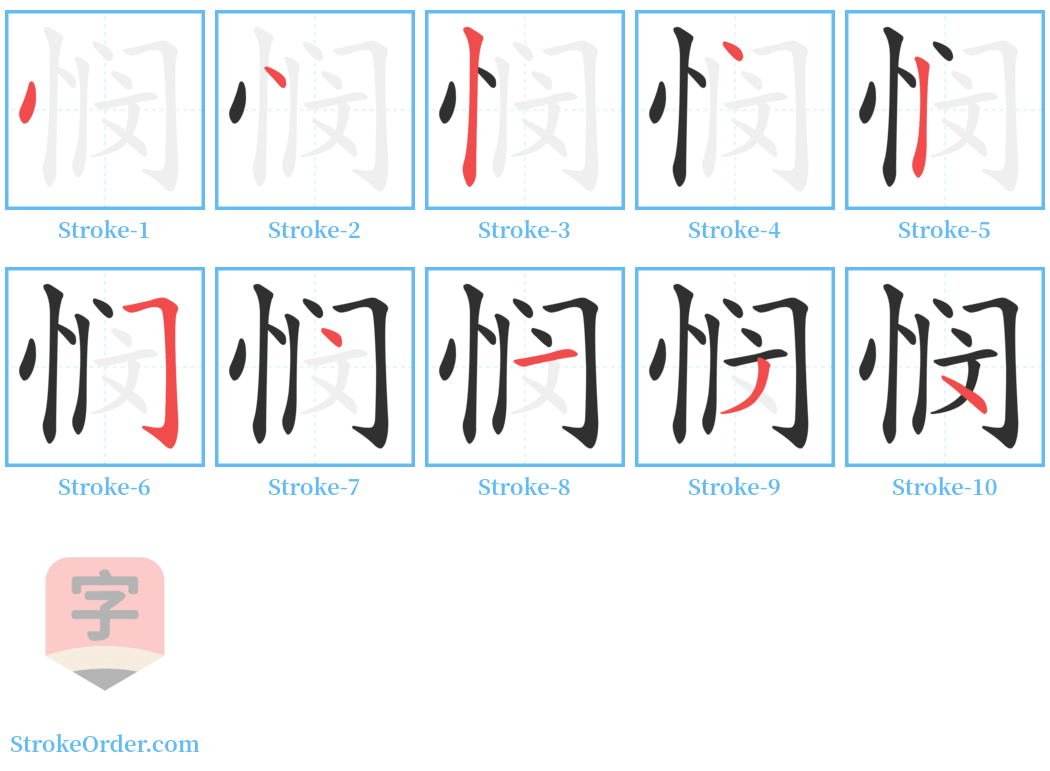悯 Stroke Order
Animated Stroke Order of 悯

Stroke Order Diagrams for 悯

Step-by-Step Handwriting Guide for 悯

Learn to Write Chinese Characters with Video Tutorials
Watch the video of writing the Chinese character "悯", learn the correct stroke order (笔顺) of the character "悯", and master the standard way of writing the character "悯".
Free Printable Handwriting Practice with Stroke Order: 悯
Printable Writing Practice Worksheet of "悯" in Portrait Orientation (Tian Zi Ge)

Printable Writing Practice Worksheet of "悯" in Landscape Orientation (Tian Zi Ge)

Information of 悯
Pinyin
mǐn
Radical
忄
Strokes
10 strokes
Usage
★★★★★
Definition
sympathize / to pity
悯 (憫 mǐn)
Part of Speech: Verb
1. 哀怜 – To commiserate; to take pity on.
2. 忧愁 – To be worried; to feel sorrow.
Meaning Expanded:
1. 哀怜
- 怜~ (to pity)
- ~恤 (to sympathize)
- ~惜 (to cherish)
- ~恻 (to feel compassion)
2. 忧愁
- ~默 (silent due to sorrow)
Derived Forms and Examples:
1. 同本义 - Same as the original meaning (English: commiserate; take pity on)
- 引用例句:
a. 白居易《新乐府序》: 隋堤柳,悯亡国也。
b. 清· 黄宗羲《朱人远墓志铭》: 人远悲天悯人之怀,岂为一己之不遇乎?
2. 例:
- 悯人之凶 (pity the vicious; implies understanding human nature with compassion)
- 悯念 (to have pity)
- 悯宥 (to pardon with pity)
- 悯笑 (to smirk with pity)
- 悯贫 (to sympathize with the poor)
- 悯然 (showing a pitiful demeanor)
Part of Speech: Adjective
1. 忧愁 (worried; sorrowful)
- 引用例句:
a. 《孟子》: 阨穷而不悯。
b. 唐· 白居易《琵琶行(并序)》: 曲罢悯然。
2. Examples:
- 悯默 (silent due to sorrow)
- 悯悯 (sorrowful expression)
- 悯愧 (to feel sorrow and shame)
- 悯叹 (to sigh sorrowfully)
- 悯时病俗 (concerned about current trends)
3. 哀伤 (sad)
- Examples:
- 悯凶 (sorrow for funerals, specifically for parents' death)
- 悯悼 (to grieve)
- 悯哀 (to lament)
Input Method for 悯
Pinyin
min3
Wubi
nuyy
Cangjie
plsk
Zhengma
utso
Four Corner
97020
Unicode
U+60af
Same Pronunciation Characters